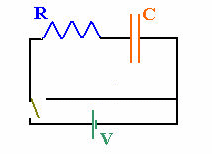 Resistors are simple circuit elements. A constant
current flows when a resistor is connected across the terminals of a
battery. If a
capacitor is added to the circuit, the situation changes. If a
parallel-plate capacitor C is connected in series with a resistor R, and
the two ends of the chain are connected to a battery as shown in the
diagram to the right, then the battery will pump electrons from the
plate connected to the negative terminal to the plate connected to the
positive terminal. The magnitude of the net charge on each plate
will increase with time as
Resistors are simple circuit elements. A constant
current flows when a resistor is connected across the terminals of a
battery. If a
capacitor is added to the circuit, the situation changes. If a
parallel-plate capacitor C is connected in series with a resistor R, and
the two ends of the chain are connected to a battery as shown in the
diagram to the right, then the battery will pump electrons from the
plate connected to the negative terminal to the plate connected to the
positive terminal. The magnitude of the net charge on each plate
will increase with time as
Q = Q0(1 - e-t/τ),
where τ = RC is the
time constant of the RC
(resistor-capacitor) circuit.
At t = 0, Q = 0, and when t becomes
very large compared to τ, then e-t/τ
<< 0, and Q = Q0 = CV0.
For the voltage
across the capacitor we have V = Q/C, so
V = V0(1 - e-t/τ),
where V0 is the battery voltage.
The current flowing in
the circuit as the capacitor is being charged is
I = ΔQ/Δt = I0e-t/τ
= (V0/R)e-t/τ.
The time it takes to charge the capacitor so that it
holds half of the maximum charge for a given voltage is t½
= τ ln2.
This is also the time it takes for
the voltage across the capacitor to be equal to ½ of the battery
voltage and the time it takes for the current to decrease to ½ of its
maximum value.
If, after the capacitor has been fully charged, it is disconnected
from the battery and the switch is closed, i.e., the RC circuit is
shorted out, then the charge on the capacitor will decrease as Q = Q0e-t/τ,
the voltage will decrease as V = V0e-t/τ,
and the current flowing in the circuit will be I = ΔQ/Δt
= -I0e-t/τ = -(V0/R)e-t/τ.
The minus sign indicates that the current that discharges the capacitor
flows in the opposite direction as the current that charges the
capacitor.

External link: RC
Circuit (bu.edu)
Please explore this simulation! It is a nice visualization of what is
happening when a capacitor charges or discharges.
Problem:
The intermittent wiper system in a car is based on an RC time constant and
utilizes a 0.40 μF capacitor. What resistance R is needed for a 2 s time
constant?
Solution:
- Reasoning:
The time constant of an RC circuit is τ = RC.
- Details of the calculation:
R = τ/C = (2 s)/(4*10-7) F = 5*106
Ω = 5 MΩ.
Why do we care about RC circuit?
All real circuits have some capacitance. Often we can model a real
circuit as a chain of capacitors and resistors connected in series and parallel.
The time constant of such a circuit characterizes the time it takes for the
capacitors to charge and discharge and therefore limits the maximum speed with
which signals can travel through the circuit. In real circuits for example
the full current does not flow the instant you flip a switch. It takes
some time to build up to its steady-state value.
 Resistors are simple circuit elements. A constant
current flows when a resistor is connected across the terminals of a
battery. If a
capacitor is added to the circuit, the situation changes. If a
parallel-plate capacitor C is connected in series with a resistor R, and
the two ends of the chain are connected to a battery as shown in the
diagram to the right, then the battery will pump electrons from the
plate connected to the negative terminal to the plate connected to the
positive terminal. The magnitude of the net charge on each plate
will increase with time as
Resistors are simple circuit elements. A constant
current flows when a resistor is connected across the terminals of a
battery. If a
capacitor is added to the circuit, the situation changes. If a
parallel-plate capacitor C is connected in series with a resistor R, and
the two ends of the chain are connected to a battery as shown in the
diagram to the right, then the battery will pump electrons from the
plate connected to the negative terminal to the plate connected to the
positive terminal. The magnitude of the net charge on each plate
will increase with time as
